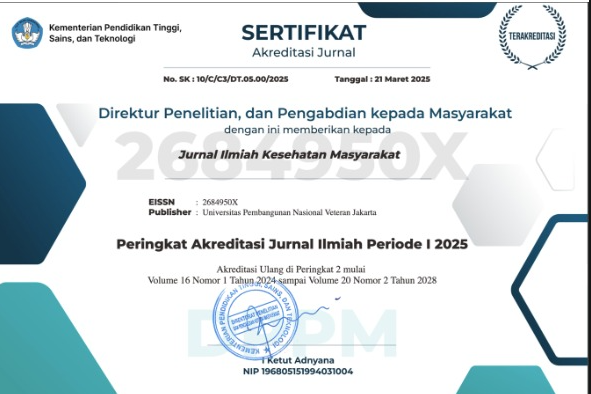Kepatuhan Prosedur dan Iklim Keselamatan di Ketinggian: Kasus pada Pekerjaan Konstruksi
Abstract
Abstrak
Latar Belakang : Bekerja di ketinggian menjadi penyumbang terbesar kecelakaan kerja di Indonesia hingga mencapai 38% dari jumlah total kasus kecelakaan kerja. Dalam mengurangi risiko jatuh dari ketinggian dapat dilakukan dengan mematuhi standar operasional prosedur (SOP) sebagai salah satu faktor yang memengaruhi kepatuhan adalah iklim keselamatan. Penelitian ini bertujuan untuk menentukan hubungan antara iklim keselamatan dan kepatuhan pekerja terhadap prosedur operasional standar (SOP) di ketinggian.
Metode: Studi kuantitatif ini menggunakan desain Cross-sectional. Sampel sebanyak 92 karyawan dipilih melalui teknik consecutive sampling yang terlibat dalam proyek pembangunan The Park Mall Sawangan. Variabel bebas iklim keselamatan diperoleh menggunakan kuesioner NOSACQ-50, variabel terikat kepatuhan diperoleh melalui wawancara kuesioner dan observasi. Dimensi iklim keselamatan yang paling mempengaruhi kepatuhan SOP pada pekerjaan di ketinggian diidentifikasi dengan menggunakan analisis multivariat regresi logistik berganda.
Hasil: Proporsi pekerja yang patuh terhadap SOP bekerja di ketinggian sebesar 58,7%, dan sebagian besar dimensi iklim keselamatan masuk dalam kategori cukup rendah. Pekerja yang memiliki persepsi yang baik tentang prioritas keselamatan pekerja dan risiko keselamatan yang tidak dapat diterima memiliki 2,51 kali lebih tinggi untuk memenuhi SOP (95%CI=1,00-6,24) dibandingkan dengan pekerja yang memiliki persepsi cukup.
Kesimpulan: Manajemen diharapkan dapat meningkatkan prioritas keselamatan dan komitmen keselamatan melalui perencanaan sistem manajemen keselamatan yang lebih matang, yang mencakup strategi peningkatan kepatuhan pekerja terhadap prosedur kerja.
Kata kunci : Bekerja di ketinggian, Iklim keselamatan, Kepatuhan
Abstract
Background: Working at height is the largest contributor to work accidents in Indonesia, reaching 38% of the total number of work accident cases. Reducing the risk of falling from a height can be done by complying with standard operating procedures (SOP) where one of the factors that influences compliance is the safety climate. This research aims to determine the relationship between safety climate and worker compliance with standard operating procedures (SOP) at height.
Methods: This quantitative study used a cross-sectional design. A sample of 92 employees was selected using a consecutive sampling technique who were involved in the Sawangan Park Mall development project. The independent variable safety climate was obtained using the NOSACQ-50 questionnaire, the dependent variable compliance was obtained through questionnaire interviews and observation. The safety climate dimensions that most influence SOP compliance for work at height were identified using multiple logistic regression multivariate analysis.
Result: The proportion of workers who comply with the SOPs for working at heigths is 58,7%, and most dimensions of the safety climate are in the quite low category. Workers who have a good perception of worker safety priorities and unacceptable safety risks are 2.51 times more likely to comply with SOPs (95%CI=1.00-6.24) compared to workers who have a fair perception.
Conclusion: Management is expected to increase safety priorities and safety commitment through planning a more mature safety management system, which includes strategies for increasing worker compliance with work procedures.
Keywords: Compliance, Safety climate, Working at height
References
Neal A, Griffin MA. Safety Climate and Safety Behaviour. Aust J Manag. 2002;27(1):67–75.
Neal A, Griffin MA. A study of the Lagged Relationships Among Safety Climate, Safety Motivation, Safety Behavior, and Accidents at the Individual and Group Levels. J Appl Psychol. 2006;91(4):946–53.
Mutia AA, Ekawati, Wahyuni I. Analisis Faktor-Faktor Yang Berhubungan Dengan Perilaku Tidak Aman Pada Pekerja di Departemen Produksi PT.X. J Kesehat Masy. 2017;5:1–9.
Prabasworo NN. Hubungan Iklim Keselamatan Kerja dengan Kepatuhan pada Peraturan Keselamatan Oleh Perawat di Rumah Sakit. Universitas Muhammadiyah Malang; 2016.
Notoadmodjo S. Kesehatan Masyarakat Ilmu & Seni. Jakarta: Rineka Cipta; 2012. 110 p.
Kines P, Törner M, Tharaldsen J, Pousette A, Mikkelsen KL, Olsen E, et al. Nordic Safety Climate Questionnaire (NOSACQ-50): A new tool for diagnosing occupational safety climate. Int J Ind Ergon [Internet]. 2011;41(6):634–46. Available from: http://dx.doi.org/10.1016/j.ergon.2011.08.004
Mulyasari W. Pengembangan Model Iklim Keselamatan Terhadap Kecelakaan Kerja dan Penyakit Akibat Kerja (PAK). Pros Semin Nas Manaj Teknol XVIII. 2013;1–9.
Muslima A. Gambaran Iklim Keselamatan (Safety Climate) di Unit Base Maintenance PT. Garuda Maintenance Facility (GMF) Aeroasia Tahun 2017. UIN Syarif Hidayatullah Jakarta; 2017.
Qolbi AN. Hubungan Antara Persepsi Iklim Keselamatan Manajemen dan Iklim Keselamatan Pekerja Terhadap Kepatuhan Pekerja KOnstruksi Pada Program K3 di Proyek Pembangunan Trans Studio Mall Bali Tahun 2019. Universitas Udayana; 2019.
Yuliarti L. Gambaran Iklim Keselamatan Kerja (Safety Climate) pada Perawat dan Tenaga Penunjang Medis di RSUD Kota Depok Tahun 2017 [Internet]. UIN Syarif Hidayatullah Jakarta; 2018. Available from: https://www.uam.es/gruposinv/meva/publicaciones jesus/capitulos_espanyol_jesus/2005_motivacion para el aprendizaje Perspectiva alumnos.pdf%0Ahttps://www.researchgate.net/profile/Juan_Aparicio7/publication/253571379_Los_estudios_sobre_el_cambio_conceptual_
Clarke S. An integrative model of safety climate: Linking psychological climate and work attitudes to individual safety outcomes using meta-analysis. J Occup Organ Psychol. 2010;83(3):553–78.
Jeffcott S, Pidgeon N, Weyman A, Walls J. Risk, trust, and safety culture in U.K. train operating companies. Risk Anal. 2006;26(5):1105–21.
Weiner BJ, Hobgood C, Lewis MA. The meaning of justice in safety incident reporting. Soc Sci Med. 2008;66(2):403–13.
Qisthina AN. Hubungan Antara Iklim Keselamatan Dengan Stres Kerja Karyawan Pabrik Minyak Sawit PT.Perkebunan Nusantara XIII Gunung Meliau Kalimantan Barat [Internet]. Universitas Islam Indonesia; 2018. Available from: https://www.uam.es/gruposinv/meva/publicaciones jesus/capitulos_espanyol_jesus/2005_motivacion para el aprendizaje Perspectiva alumnos.pdf%0Ahttps://www.researchgate.net/profile/Juan_Aparicio7/publication/253571379_Los_estudios_sobre_el_cambio_conceptual_
Devis, Newstrom. Organizational Behavior: Human Behavior at Work. McGraw-Hill College; 1985.
Inouye J. Risk Perception: Theories, Strategies, and Next Step. Campbell Institute; 2014.
Vinodkumar MN, Bhasi M. Safety management practices and safety behaviour: Assessing the mediating role of safety knowledge and motivation. Accid Anal Prev [Internet]. 2010;42(6):2082–93. Available from: http://dx.doi.org/10.1016/j.aap.2010.06.021
Neal A, Griffin MA HP. Safety Climate and Safety at Work. 2004. 15–34 p.
Cooper MD, Phillips RA. Exploratory analysis of the safety climate and safety behavior relationship. J Safety Res. 2004;35(5):497–512.
Widyastuti M, Nur’aini S. Hubungan Antara Iklim Keselamatan Kerja Terhadap Perilaku Berbahaya Pada Karyawan Produksi PT. Perkebunan Nusantara XI (Persero) PG. Djatiroto. Insight. 2014;10(1):87–101.
Dejoy DM, Schaffer BS, Wilson MG, Vandenberg RJ, Butts MM. Creating safer workplaces : assessing the determinants and role of safety climate. 2004;35:81–90.
Choudhry RM, Fang D, Lingard H. Measuring Safety Climate of a Construction Company. 2009;(September):890–9.
Ashfahany MZW Al. Kekuatan Komunikasi Sebagai Faktor Penunjang Keselamatan Kerja Pada Industri Manufaktur. IAIN Surakarta; 2017.
Schwatka N V, Rosecrance JC. Safety climate and safety behaviors in the construction industry : The importance of co-workers commitment to safety. 2016;54:401–13.
Agiviana AP, Djastuti I. Analisis pengaruh persepsi, sikap, pengetahuan dan tempat kerja terhadap perilaku keselamatan karyawan. Diponegoro J Manag. 2015;4:1–9.
Noviandry I. Faktor-Faktor Yang Berhubungan Dengan Perilaku Pada Industri Pengelasan Informal Di Kelurahan Gondrong , Kecamatan Cipondoh , Kota Tangerang Program Studi Kesehatan Masyarakat. UIN Syarif Hidayatullah Jakarta; 2013.
Neal A, Griffin MA HP. The Impact of Organisational Climate on Safety Climate and Individual Behaviour. J Saf Sci. 2000;XXXIV:99–109.









.jpg)








